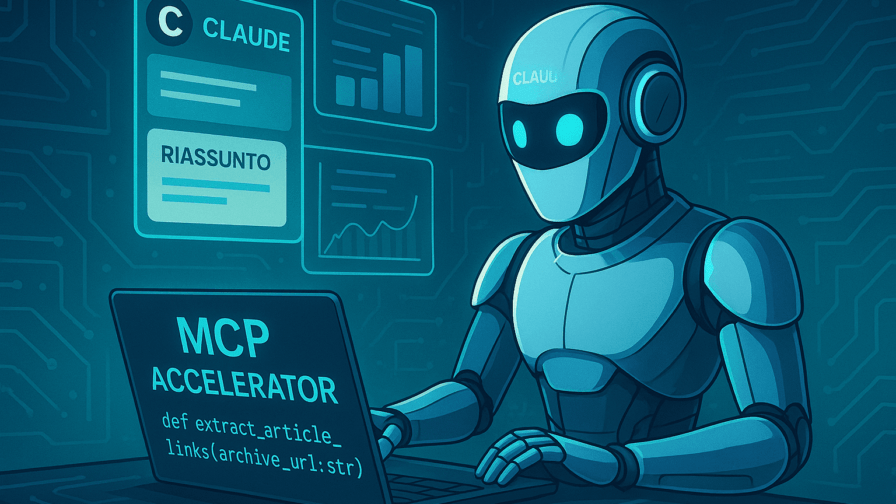
As artificial intelligence continues to evolve rapidly, AI agents are no longer isolated entities answering isolated queries. Instead, they act as orchestrators in complex ecosystems, communicating with other tools, accessing multiple data sources, collaborating within multi-agent systems, and performing actions based on data-informed reasoning. At the heart of this transformation lies the Model Context Protocol (MCP), a crucial technology powering efficient AI agent connections to data resources, context management, and scalable architectures.
In the sections that follow, I’ll provide a strategic overview of how MCP servers enable advanced AI setups, the role of context management, and how to build multi-agent systems that harness collective intelligence.
The Communication Challenge for AI Models
As opposed to AI models, which can only reference the static data sets that they’re trained on, AI agents often need to augment their capabilities by accessing external data sources such as databases, APIs, or real-time streams.
They might also need to interact with diverse tools, from data analysis engines to messaging platforms, to fulfill user requests effectively.
Traditionally, for cloud-based apps that we’re used to, this involved hardcoding integrations, writing custom connectors for every tool or data source, and handling disparate authentication and data formats. This approach is fragile, complex, and not scalable.
Enter the Model Context Protocol (MCP)
The Model Context Protocol, developed by Anthropic and open-sourced in late 2024, addresses a critical gap in AI infrastructure. Prior to MCP, every AI-to-external-system integration required bespoke development, creating a fragmented landscape of non-interoperable solutions.
MCP establishes a universal communication layer that enables AI agents to seamlessly interact with multiple external sources, including databases, APIs, file systems, and cloud services through a standardized interface. Designed as an open JSON-RPC 2.0 protocol, MCP acts like a universal interface. You could call it the USB-C port for AI applications.
MCP decouples the AI agent from the complexities of each underlying tool or dataset by introducing MCP servers as structured gateways to these resources.
- MCP Client: Typically the AI agent or LLM-powered application initiating requests
- MCP Server: Lightweight programs exposing APIs, databases, or specialized tools in a standardized way
- MCP Host: The overarching system orchestrating client-server interactions
How MCP Servers Facilitate Agent Communication with Data Sources
Modern AI systems, agents don’t operate in a vacuum. They access everything from structured databases, vector stores, REST APIs and unstructured web data to even other agents.
“AI frameworks are the new runtime for intelligent agents, defining how they think, act, and scale,” explains Ariel Shulman, Chief Product Officer at Bright Data. “Powering these frameworks with real-time web access and reliable data infrastructure enables developers to build smarter, faster, production-ready AI systems.”
Indeed, AI agents with access to tools and memory can perform sophisticated reasoning, but only if their data interactions are coherent and scalable. Without an MCP, systems often face
- Context leakage: Agents can’t access or remember past events effectively.
- Redundant tool calls: Multiple agents may call the same API with conflicting logic.
- Poor coordination: Without a shared execution plan, agents compete or stall on task ownership.
- Debugging difficulty: Without centralized logging and observability, agent workflows are opaque.
An MCP server provides a programmable interface for registering tools and exposing them via a controlled endpoint. Agents submit tool usage requests, often in natural language or a serialized command schema. The MCP handles
- Authentication and access control
- Rate limiting and retries
- Response transformation (from HTML to structured JSON, for instance)
By implementing an MCP server, developers can centralize decision-making, enable shared memory, manage tool execution queues, and enforce fine-grained access controls—all while maintaining a clean, modular architecture. The implications for enterprise architecture are profound…
Implications for Real-World Applications
Developers can seamlessly integrate AI with existing enterprise systems without creating tight coupling between the AI layer and underlying services. MCP servers act as translation layers, converting between the standardized MCP protocol and the specific APIs, databases, or file systems they represent.
For organizations looking to implement sophisticated web data extraction workflows or create intelligent, context-aware applications, MCP totally revolutionizes how AI agents interact with web-based data sources, how they extract and structure data or web content, and how they use it in their reasoning process.
Developers can use an MCP server to build a scalable, AI-powered scraping workflow by configuring AI agents to access live web datasets, run custom scripts, bypass bot protections, and dynamically extract and process data.
This allows for various integration patterns suited to different use cases and organizational requirements, such as
- Enterprise Data Integration: These scenarios often involve connecting agents to existing data warehouses, CRM systems, and business intelligence platforms. MCP servers can provide unified access to disparate systems while maintaining existing security and governance frameworks.
- Development Tools and Methodologies: AI agents can now interact with code repositories, CI/CD pipelines, and deployment systems, supporting automated development workflows and intelligent code assistance.
- Customer Service Automation: MCP’s ability to connect agents to ticketing systems, knowledge bases and customer databases enables sophisticated, automated and real-time support interactions that maintain context across multiple channels and systems.
Context Management in AI Agents
AI agents derive their responses from information they “remember” or hold in working memory, known as context. Context management is critical for ensuring that an agent understands the current task, user intent, and relevant background.
Poor context management can result in repetitive, inefficient, or even erroneous responses. Advanced AI applications often need to handle
- Dynamic and evolving conversation histories
- Different context needs for multiple agents working on a collaboration
- Efficient storage to avoid exceeding model token limits while preserving essential information
“As you can imagine, the context grows with every step, while the output—usually a structured function call—remains relatively short,” says Yichao Ji, Co-Founder of Manus AI. “This makes the ratio between prefilling and decoding highly skewed in agents compared to chatbots.”
There are several techniques you can use to optimize context handling in AI agents:
- Metadata Tagging: Adding simple or AI-generated labels to messages helps agents preselect relevant context. For example, tags can identify which agent produced a message or what function it corresponds to.
- Context Prioritization: Different agents have different context depth needs. Some require only the latest interaction, while others may need an extended history.
- Dual Processing for Retrieval-Augmented Generation (RAG): Using a faster, cheaper model to condense or filter retrieval results before feeding them into a powerful agent optimizes speed, cost, and accuracy.
- Context Engineering: An iterative, experimental process of refining prompts, message structures, and context windows to improve agent behavior without retraining models.
Effective context management transforms AI agents from static answering machines into intelligent collaborators that learn and adapt through ongoing interaction.
Building Multi-Agent Systems
A multi-agent system (MAS) consists of multiple autonomous AI agents working collaboratively or competitively to solve complex problems or deliver services. Each agent typically specializes in a certain role, such as data gathering, analysis, or execution, and communicates with others to achieve collective goals.
Based on these roles, multi-agent systems improve scalability and efficiency by breaking tasks into smaller, specialized units. Use cases include:
- Document processing pipelines
- Market or data analytics with distributed expert agents
- Personalized customer support combining technical, billing, and product expertise agents
- AI gaming and strategic applications
By carefully designing agent roles, communication, and coordination, MAS can outperform single-agent systems for large-scale and complex AI challenges.
Some critical architectural considerations include:
- Centralized vs. Decentralized Architecture: Centralized systems rely on a single orchestrator that manages communication and decision-making, which simplifies coordination but introduces a potential single point of failure. Decentralized systems distribute control among agents, improving robustness and scalability but increasing complexity of coordination protocols.
- Communication Protocols: Agents use agreed-upon protocols (e.g., MCP, Agent Communication Language) to exchange messages, negotiate tasks, or share knowledge.
- System Goals: The desired outputs define how different AI agents work together in the system. For example, cooperative agents work together toward shared goals with resource sharing and live updates, adversarial agents compete against each other (as in gaming), hierarchical agents feature a structured command chain for optimized workflows, and so on.
How to Set Up an MCP Server: High-Level Steps
Here’s the technical gist for setting up your own MCP infrastructure:
- Choose Your Transport
Decide whether your MCP server will run as a local subprocess (STDIO transport) or as a network service (HTTP + SSE). STDIO is simplest for embedding in a desktop client or CLI tool; the LLM host spawns your server process and communicates over its stdin/stdout. HTTP + SSE lets you run the server centrally (e.g. Kubernetes) and have multiple clients connect via secure HTTP endpoints.
- Define Your “Tools” and “Resources”
Using your MCP SDK (Python, TypeScript, etc.), declare each callable function as an MCP Tool, with Name & Description (for model prompts), Input Schema (JSON-RPC params) and Output Schema (JSON-RPC result). You may also define resources (read-only data streams) that the model can re-fetch later.
- Implement the JSON-RPC Server
Wire up a handler for the initialize and list_tools discovery methods. For each tool method, implement a JSON-RPC request handler that runs your business logic (e.g. web scrape, DB query) and returns structured JSON. Handle errors via the JSON-RPC error object so the LLM client can recover or retry gracefully.
- Advertise & Discover
When the LLM client connects, it calls your server’s list_tools endpoint to retrieve the full tool catalog. Make sure each tool’s name, description, and parameter schema are complete. These are what the LLM “sees” when deciding which tool to invoke.
- Configure the LLM Client
In Claude Desktop, Cursor IDE, or your own code using Anthropic’s Agents SDK, point the MCP client at your server’s STDIO or HTTP URL. The client will automatically fetch your list_tools and keep a persistent channel open. Test by sending a “function call” prompt (e.g. {“tool”:”get_price”,”params”:{“url”:”…”}}) and verifying you get valid JSON back in context.
- Deploy, Secure & Monitor
Containerize your server (Docker, Kubernetes, or similar) and expose only the necessary port or socket. Implement authentication (OAuth tokens or mTLS) so only authorized LLM clients can call your tools. Add structured logging for every JSON-RPC request/response. Track metrics like call latency, error rates, and throughput. Iterate by updating your tool schemas, adding new tools, and refining error-handling based on real calls from your LLM agents.
Evolution of the MCP and Multi-Agent Ecosystem
The MCP ecosystem continues to evolve rapidly, with ongoing development in areas such as improved stateless operations for cloud-native deployments, enhanced security frameworks, and extended protocol capabilities for specialized use cases, making MCP more suitable for large-scale enterprise applications.
Further, integration with emerging protocols like Google’s Agent-to-Agent (A2A) protocol are enabling richer multi-agent ecosystems that leverage the strengths of different communication standards.
MCP represents a fundamental shift in how AI agents interact with external systems, moving from fragmented, custom integrations to standardized, interoperable communication. For developers and IT professionals building next-generation AI systems, understanding and implementing MCP servers is becoming increasingly critical.
As the AI agent ecosystem continues to mature, MCP’s role as a foundational communication standard will likely expand, making early adoption and expertise development valuable investments for organizations seeking to leverage the full potential of autonomous AI systems.
Coupled with sophisticated context management and multi-agent system architectures, MCP empowers organizations to build highly adaptive, efficient, and intelligent AI workflows, paving the way for a new era of AI-enhanced automation.
For IT leaders, professionals and system developers shaping AI strategies, understanding and harnessing MCP, context engineering, and multi-agent architectures is paramount to staying at the forefront of innovation.




